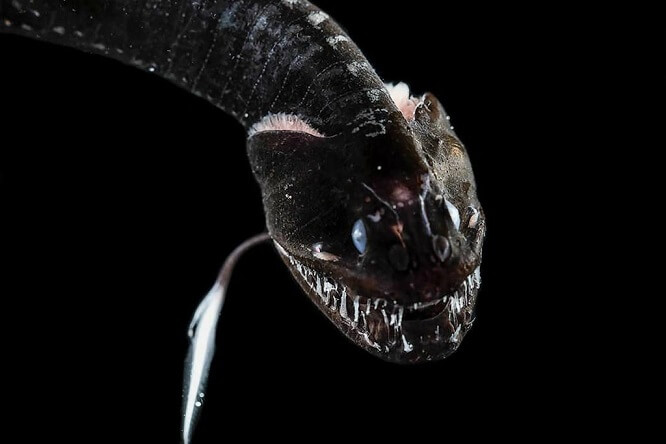By Stephen Johnson | Big Think
Key Takeaways
- A team of marine biologists used nets to catch 16 species of deep-sea fish that have evolved the ability to be virtually invisible to prey and predators.
- “Ultra-black” skin seems to be an evolutionary adaptation that helps fish camouflage themselves in the deep sea, which is illuminated by bioluminescent organisms.
- There are likely more, and potentially much darker, ultra-black fish lurking deep in the ocean.
A team of marine biologists has discovered 16 species of “ultra-black” fish that absorb more than 99% of the light that hits their skin, making them virtually invisible to other deep-sea fish.
The researchers, who published their findings Thursday in Current Biology, caught the species after dropping nets more than 200 meters deep near California’s Monterey Bay. At those depths, sunlight fizzles out. That’s one reason why many deep-sea species have evolved the ability to illuminate the dark waters through bioluminescence.
But what if deep-sea fish don’t want to be spotted? To counter bioluminescence, some species have evolved ultra-black skin that’s exceptionally good at absorbing light. Only a few other species are known to possess this strange trait, including birds of paradise and some spiders and butterflies.
When researchers first saw the deep-sea species, it wasn’t immediately obvious that their skin was ultra-black. Then, marine biologist Karen Osborn, a co-author on the new paper, noticed something strange about the photos she took of the fish.
“I had tried to take pictures of deep-sea fish before and got nothing but these really horrible pictures, where you can’t see any detail,” Osborn told Wired. “How is it that I can shine two strobe lights at them and all that light just disappears?”
After examining samples of fish skin under the microscope, the researchers discovered that the fish skin contains a layer of organelles called melanosomes, which contain melanin, the same pigment that gives colour to human skin and hair. This layer of melanosomes absorbs most of the light that hits them.
“But what isn’t absorbed side-scatters into the layer, and it’s absorbed by the neighbouring pigments that are all packed right up close to it,” Osborn told Wired. “And so what they’ve done is create this super-efficient, very-little-material system where they can basically build a light trap with just the pigment particles and nothing else.”
The result? Strange and terrifying deep-sea species, like the crested bigscale, fangtooth, and Pacific blackdragon, all of which appear in the deep sea as barely more than faint silhouettes.
But interestingly, this unique disappearing trick wasn’t passed on to these species by a common ancestor. Rather, they each developed it independently. As such, the different species use their ultra-blackness for different purposes. For example, the threadfin dragonfish only has ultra-black skin during its adolescent years, when it’s rather defenceless, as wired notes.
Other fish—like the oneirodes species, which use bioluminescent lures to bait prey—probably evolved ultra-black skin to avoid reflecting the light their own bodies produce. Meanwhile, species like C. acclinidens only have ultra-black skin around their gut, possibly to hide light of bioluminescent fish they’ve eaten.
Given that these newly described species are just ones that this team found off the coast of California, there are likely many more, and possibly much darker, ultra-black fish swimming in the deep ocean.
Now That’s Interesting
Approximately 98% of the ocean’ species live in, on, or just above the floor of the sea. The estimated number of seamounts ranges from 30,000 to 100,000. Seamounts are home to a breathtaking array of species (for example, over 850 species were found on seamounts in the Tasman and Coral Seas).
* * *
READ MORE: Great White Sharks Are Being Scared From Their Habitat By Just 2 Predators
Read more on Deep Sea Creatures: Octopuses Are Deep Sea Bullies That Punch Fish Out Of ‘Spite’ Or Just For Fun, Study Finds
Telegram: Stay connected and get the latest updates by following us on Telegram!
We’d love to hear from you! If you have a comment about this article or if you have a tip for a future Collective Spark Story please let us know below in the comment section.

